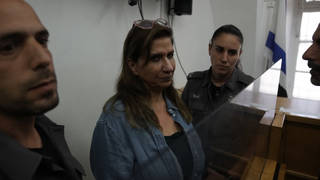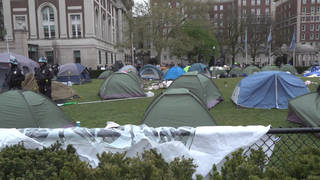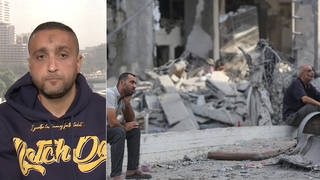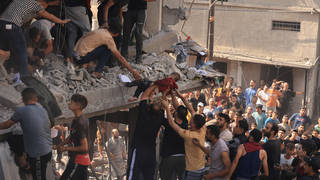
Related
Guests
- Muhammad Shehadawriter and activist from the Gaza Strip and a student of development studies at Lund University, Sweden. He writes for Haaretz, The Forward and other publications.
The death toll in Gaza has risen to at least six after Israel launched its heaviest airstrikes on the region since 2014, targeting scores of buildings, including the TV station Al-Aqsa TV. Israeli airstrikes also reportedly hit dozens of homes. Militants in Gaza responded by launching hundreds of homemade rockets into Israel. One person in Israel, a Palestinian man in Ashkelon, was reportedly killed. Some 16 others were injured, including at least two critically. The escalation began after a team of Israeli commandos drove into the southern Gaza city of Khan Younis Sunday in a clandestine raid that killed seven Hamas members, including a commander. Israel said one of its soldiers had been killed in an exchange of fire before Israel called in tank fire and airstrikes while the commandos escaped back to Israel. We speak with Muhammad Shehada, a writer and activist from the Gaza Strip and a student of development studies at Lund University, Sweden. He writes for Haaretz, The Forward and other publications.
Transcript
AMY GOODMAN: This is Democracy Now! I’m Amy Goodman, with Juan González.
JUAN GONZÁLEZ: The death toll in Gaza has risen to at least six after Israel launched its heaviest airstrikes on the region since 2014, targeting scores of buildings, including a TV station, Al-Aqsa TV. Israeli airstrikes also reportedly hit dozens of homes. Militants in Gaza responded by launching hundreds of homemade rockets into Israel. One person in Israel was reported killed, a Palestinian man in Ashkelon. Sixteen others were injured, including at least one—two critically. The recent escalation began after a team of Israeli commandos drove into the southern Gaza city of Khan Younis Sunday in a clandestine raid that killed seven Hamas members, including a commander. Israel said one of its soldiers had been killed in an exchange of fire before Israel called in tank fire and airstrikes while the commandos escaped back to Israel.
AMY GOODMAN: Well, for more, we’re joined by Muhammad Shehada, a writer and activist from the Gaza Strip, writes for Haaretz, The Forward and other publications.
Muhammad, welcome to Democracy Now! Can you explain to us what you understand is happening in Gaza, as you join us from Sweden, where you’re a student?
MUHAMMAD SHEHADA: Well, it started with Israel carrying out an undercover assassination against the top Hamas leader, Nour Baraka, at the worst and most inexcusable time one could ever think about: only a few days after Hamas and Israel supposedly reached an understanding to restore tranquility and calm and reintroduce progress to Gaza. Once the Israeli cover was blown up, Hamas retaliated with a barrage of improvised, primitive projectiles on Israel’s south, with the aim to draw a red line of deterrence for Israel, that it cannot do as it may please in the Gaza Strip. Israel responded immediately with an explicit implementation of the Oxford definition of “terrorism,” basically intimidating and terrorizing Gaza’s civilian caged population as an instrument to achieve political gains—essentially, to send strong messages to Hamas and, according to a senior Israeli officer, exact a price from the other side.
The bombed buildings are usually predesignated targets, where Israel’s choice of the next target is carefully calibrated in accordance with the desired magnitude of pain it wishes to leave Gaza with in order to teach it a lesson, so that when people wake up, they see destruction, rubble and funerals everywhere. They would be, presumably, terrorized back into passivity. This morning, a senior Israeli Air Force commander said that the nature of the targets, quote, “are completely different from anything we’ve known in the past.” These targets are high-rise buildings in the city centers.
AMY GOODMAN: Can you talk—
MUHAMMAD SHEHADA: And so, eight—
AMY GOODMAN: Can you talk about the bombing of Al-Aqsa TV in Gaza?
MUHAMMAD SHEHADA: Well, basically, Israel claims to have warned people in advance that the building is going to be targeted, a compound for Al-Aqsa TV. However, it doesn’t make it any better to give people a choice between losing their constructions or homes or losing their lives. Today, for instance, people were awakened at 4:30 in the morning, in the very early morning, to an Israeli phone call saying, “You have only one minute to leave your homes, or else you will die inside them.” Afterwards, Al-Yaziji Tower, in the very heart of Gaza, was obliterated from existence, reduced to rubble and misery. And people—that construction, in addition to seven others, including Al-Aqsa TV compound, used to house tens of Gazan families, civilian families, essentially, including kindergartners—kindergartens and entrepreneurial centers. So what we are seeing here is that Israel is trying to teach Gazans a lesson not to walk out of the line, not to be loud about their slow death, by inflicting the severest and most traumatic pain it could afford to do.
JUAN GONZÁLEZ: Could you talk about the timing of this assassination attempt that touched off these latest troubles, especially in light of the fact that there appear to be at least some potential for restarting some kind of negotiations between Israel and the Palestinians and the involvement of other powers in the region in some sort of mediation?
MUHAMMAD SHEHADA: Well, Gaza has shown extraordinary commitment to overwhelming nonviolence over the last at least six months of protest, demanding the right to life at the 5-meter fence that entraps the enclave. Eventually, Israel decided that if the protests are distant from the fence, in return, Gaza would be given an influx—an increase in the influx of Qatari fuel and money to pay the salaries of government officials, and increase the electricity daily dose for Gaza’s population. However, once this, let’s say, ceasefire understanding settled in, Israel seized the opportunity to immediately target Hamas, thinking that they cannot retaliate, with the interest of maintaining the ceasefire. We are seeing, apparently, international efforts to restore progress in the Gaza Strip that are being exterminated from existence by the Israeli persistence to play a political game other than caring for the humanitarian crisis in Gaza.
AMY GOODMAN: Can you give us the context? When you talk about the last six months of peaceful protest, since March 30th, over 200 Palestinians have been killed by Israeli forces in Gaza. What is the number? Fifteen thousand, 18,000 injured, more than 5,000 of them shot by Israeli soldiers. Can you talk about these ongoing protests and what the demands are now in Gaza?
MUHAMMAD SHEHADA: Well, basically, Gaza has been rendered unlivable by the year 2020 by the United Nations. The United Nations officials came out recently to say that “We’ve been optimistic about this deadline. Gaza is already, in fact, unlivable.” If you look at the humanitarian situation in Gaza, you have an ever-increasing segment of extreme poverty. About 80 percent of the population depend on food packages and humanitarian aid to survive. And you have 97 percent of the water unfit for human consumption, totally polluted.
For this, Gazans decided to rise against their slow death and take initiative with their own hands. People have been marching to the Gaza borders for more than six months every Friday, and on other days of the week, to demand their right to life, to demand that the blockade shall be removed. And Israel, time and again, refuse to of knowledge the basic facts that people in Gaza are caged in a toxic slum from birth to death, where they are being suffocated out of hope, out of life, out of any sense for progress, and hollowed out of their souls eventually. And hence, they came to the borders to bring it down, to bring the bars that surround Gaza and besiege it into slow death down. And that’s basically what they were demanding, that they shall no longer suffer at this time of their history.
AMY GOODMAN: Your final words—we have about 30 seconds—on the situation and what you feel needs to be done?
MUHAMMAD SHEHADA: Well, The Guardian, a couple of years ago, opened an op-ed by saying Palestinian nonviolence should be met by global nonsilence. However, the equation that we have here is that if Gazans do not throw rockets or improvised projectiles, nobody at all listens to them whatsoever. Once these projectiles begin to fly over Israel, immediately the international community is concerned with restoring tranquility. However, what is made synonymous to tranquility is restoring the status quo that led to the explosion of these troubles in the first place, the very suffocating status quo. So it’s a catch-22 that is being repeated over and over again. What Gaza needs in order to assuage existing problems, including security problems, is the very minimum of human dignity. They need to live as other people around the world, clear and simple.
AMY GOODMAN: We want to thank you so much for being with us, Muhammad Shehada, writer and activist from Gaza Strip, student of development studies at Lund University in Sweden, where he’s speaking to us from. Muhammad writes for Haaretz, The Forward and other publications.











Media Options